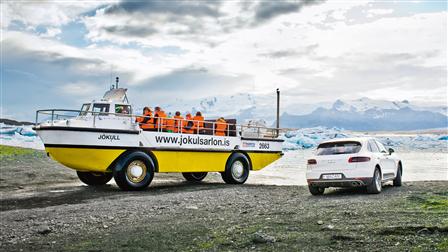
In the Land of the Vikings
Pétur Lentz: “I’m a pilot for Icelandair and the president of
Iceland is in vogue, and not just since its soccer team and fans delighted spectators and the media at this year’s European soccer championship. The country is its own cosmos: a world of myths, extraordinary natural scenery, and passionate people. We visit
Our adventure in Iceland begins long before this story. It starts with Pétur Lentz, the president of
As clouds chase each other across the sky, interrupted alternately by rays of light and squalls, I arrive at Lentz’s house in Garðabær, not far from Reykjavík. There is nothing special about this weather; it’s just a normal day in Iceland. Stefan Bogner is in the front yard, sorting his camera equipment and waxing euphoric about the island’s breathtaking open spaces, clear air, and incredible colors. “The weather changes every ten minutes here,” he exclaims, looking around and expecting us to nod in agreement. We Icelanders—all Club members except me—shrug our shoulders politely, but do not share Bogner’s sense of novelty. Yes, the weather changes here, often by the minute. Yes, open space abounds here, which is nothing new. Yes, the air is clear—at least until a volcano clears its throat. It’s not that we Icelanders are unaware that the countless shades of green here send visitors into raptures. But we can’t keep telling each other every day how special our ordinary surroundings are. When we visit the Continent, we too are impressed by a number of things, but we tend not to dwell on them. Sometimes Icelanders are viewed as cool, or even standoffish—a widespread misconception, or perhaps simply a stubborn assertion made by all those who expect effusive displays of friendliness and superficial smiles of welcome in Iceland.
![[+]](https://files.porsche.com/filestore/image/multimedia/none/christophorus-issue378-article05-content-01/normal/d7451543-75af-11e6-9a3c-0019999cd470/porsche-normal.jpg)
Round-trip: The best way to circumnavigate the island is on the Hringvegur, the famous Ring Road.
Einar Hörður Sigurðsson: “My
At slightly more than 100,000 square kilometers, Iceland is the second-largest island nation of Europe, after the United Kingdom. Green only in summer, it has many volcanoes, rivers, and lakes, plus slightly more than 330,000 people, of whom nearly 300,000 were born here. There is a sense of community in this country, with its mild winters and cool summers that rarely exceed 20 degrees Celsius. Cars are very important for Icelanders, by the way, on account of the vast expanses. Nearly 75 percent of the population drives on a daily basis.
While Bogner is still describing the aerial views of the landscape during his flight with the
![[+]](https://files.porsche.com/filestore/image/multimedia/none/christophorus-issue378-article05-content-02/normal/decd322d-75af-11e6-9a3c-0019999cd470/porsche-normal.jpg)
Road trip: The journey continues in a
Baldvin Þór Ellertsson: “The rear of a 911 is the most beautiful view imaginable—the most gorgeous backside of any car ever made. Marvelous, isn’t it, that precisely this is what other drivers get to see of my
Braving the headwinds
We continue on to Route 36, or Þingvallavegur, a road leading through a national park, which many consider Iceland’s most scenic route. Bright sunlight makes the wet ground shine and the horizon sparkle. Lentz accelerates, and the
Soup, not boiled sheep’s head
We stop at a fjord from which an amphibious vehicle suddenly emerges, and I climb into a white
Berglind Jóhannsdóttir: “Fortunately my husband is simply too tall—he doesn’t fit in my
We drive through Grafningur in the southwest, and then past Lake Úlfljótsvatn. Sunlight alternates with drizzle, and we plow through the occasional puddle on the asphalt. The cars become dirtier by the hour, and the temperature drops markedly. We stop at a tiny shop near the lake, and order some soup to warm up. Legend has it that we Icelanders like to eat marinated herring and boiled sheep’s head. But I also love soup, as do my companions.
We turn around. It’s time to return to Reykjavík. For me the excursion will end this evening in the capital city. Lentz and his friends, however, will set off on a three-day trip around the island. They’ll start by heading to the stormy north, which will provide excellent photo opportunities. They will spend three nights in three different cities: Akureyri, Egilsstaðir, and Kirkjubæjarklaustur. Their trip in a
Text by Hrefna Gylfadóttir
Photos by Stefan Bogner
The northernmost
![[+]](https://files.porsche.com/filestore/image/multimedia/none/christophorus-issue378-article05-content-03/normal/cb08fec7-79b4-11e6-9a3c-0019999cd470/porsche-normal.jpg)
Through wind and weather: Some of
![[+]](https://files.porsche.com/filestore/image/multimedia/none/christophorus-issue378-article05-margin-01/normal/decd322f-75af-11e6-9a3c-0019999cd470/porsche-normal.jpg)
![[+]](https://files.porsche.com/filestore/image/multimedia/none/christophorus-issue378-article05-margin-02/normal/e671dfa2-75af-11e6-9a3c-0019999cd470/porsche-normal.jpg)
![[+]](https://files.porsche.com/filestore/image/multimedia/none/christophorus-issue378-article05-margin-03/normal/e671dfa3-75af-11e6-9a3c-0019999cd470/porsche-normal.jpg)
![[+]](https://files.porsche.com/filestore/image/multimedia/none/christophorus-issue378-article05-margin-04/normal/ed7bd377-75af-11e6-9a3c-0019999cd470/porsche-normal.jpg)








